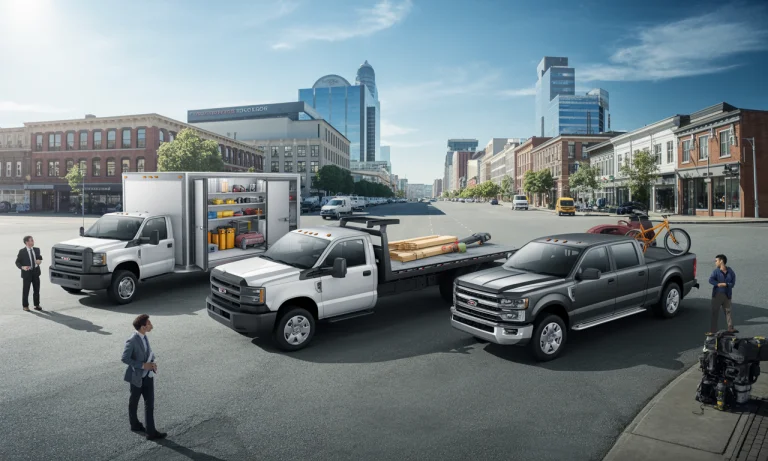Every morning before dawn, business owners and fleet managers face a quiet, crucial test: will today’s truck meet the demands of a chaotic delivery schedule, unpredictable weather, and the weight of customers’ expectations? The transport sector thrives on precision, and choosing the right truck can mean the difference between profit and persistent headaches. Industry giants like Ford, Chevrolet, and Ram have refined their offers, but the challenge remains: which is truly right for your operations? Behind every truck make and model is a universe of payloads, terrains, and evolving technologies waiting to shape your business journey. Dive into a landscape where operational efficiency and cost savings aren’t luxuries—they’re survival tactics. As competitors load up fleets of Toyota, Nissan, Mercedes-Benz, Isuzu, Hino, and Kenworth vehicles, your decision today could redefine tomorrow’s success.
Defining Your Commercial Truck Needs: Payload, Terrain, and Body Style
For years, Alisha, owner of a flourishing floral distribution company, relied on intuition to choose the trucks in her fleet. But as her business expanded, every miscalculation meant lost flowers and frayed contracts. She learned the hard way that payload capacity is more than a specification—it’s a promise to clients. Measuring the average load is vital; exceeding it not only voids warranties but opens the door to penalties and delays.
Urban deliveries on winding streets favor nimble trucks, often light-duty models from Ford or GMC. In contrast, builders trekking over gravel and mud might seek the resilience of a Chevrolet or a Kenworth, both offering robust off-road packages. And when precious cargo is on the line, such as frozen foods or pharmaceuticals, refrigerated bodies—often found in fleets with Mercedes-Benz or Isuzu—become non-negotiable assets.
| Industry | Recommended Body Style | Brands Commonly Chosen |
|---|---|---|
| Construction | Flatbed/Heavy-Duty | Chevrolet, Kenworth, GMC |
| Logistics | Box/Refrigerated | Isuzu, Mercedes-Benz, Hino |
| Urban Deliveries | Light/Medium Duty | Ford, Nissan, Toyota |
Assessing the Right Truck Class for Business Growth
As pressure to scale up services mounts, the dichotomy between light, medium, and heavy-duty trucks becomes more pronounced. Alisha’s initial foray into medium-duty GMC trucks permitted her to double her delivery radius overnight. Yet, she quickly noticed gaps: small trucks excelled in traffic, while larger ones struggled with parking but shone on interstate hauls. By carefully aligning each route with the right truck type, she not only increased efficiency, but slashed unnecessary fuel expenses.
Leveraging Fuel Efficiency and Advanced Engine Technology
Profit margins often evaporate at the pump. Enter 2025’s race for efficiency: as fuel prices swing and environmental scrutiny tightens, the gap between traditional engines and alternatives like hybrid or electric widens. According to industry trackers, Toyota and Nissan have refined hybrid trucks for local deliveries, while manufacturers have turned turbocharged engines into a mainstream solution for balancing power and consumption.
Alisha’s switch to Mercedes-Benz electric vans for certain high-density city routes halved her refueling stops. She was also able to market her company’s green credentials, aligning with clients who prioritized sustainability. Still, for longer journeys or heavier payloads, heavy-duty diesel options from Ram or Hino remained her backbone.
| Engine Type | Use-case | Leading Brands |
|---|---|---|
| Hybrid/Electric | Urban Deliveries, Eco-Fleets | Nissan, Toyota, Mercedes-Benz |
| Turbocharged Diesel | Long-haul, Heavy Loads | Ram, Kenworth, Hino |
Assessing Safety Features in Modern Commercial Trucks
After a close call on a foggy highway, Alisha made safety her new obsession. Features like adaptive cruise control and lane departure alerts, now standard on most Ford and Chevrolet models, suddenly seemed priceless. Blind-spot monitoring, stability control, and advanced airbag systems became non-negotiables, especially as insurance premiums inched higher with every reported incident.
She also realized that trained drivers alone weren’t enough. A diversified fleet with the latest in active safety technology reduced not only accident rates but also operational downtime. Choosing vehicles with robust safety packages now formed the backbone of her acquisition strategy.
Understanding Maintenance, Repairs, and Support Networks
The hidden cost of an unreliable truck can spiral: delayed shipments, lost contracts, angry clients. Perhaps nowhere is the difference between brands as visible as in maintenance and parts availability. Alisha found solace with GMC and Isuzu, whose dealer networks responded quickly even during peak seasons. By contrast, a brief experiment with an exotic brand ended in weeks of immobilized assets.
Before adding any vehicle, Alisha cross-referenced parts costs and service availability with seasoned mechanics. This diligence paid dividends: fewer breakdowns, faster turnarounds, and a reputation for reliability that became her calling card. When tough decisions loomed—such as considering a new Hino long-hauler—she first polled peers on the real cost of downtime versus listed price.
| Brand | Service Coverage | Parts Cost Index |
|---|---|---|
| GMC | Extensive national | Moderate |
| Isuzu | Strong urban & rural | Low |
| Hino | Selective metro | Moderate |
Strategic Test Drives and Ergonomic Evaluation
It’s easy to get dazzled by spec sheets or showroom aesthetics, but nothing replaces the truth revealed during a test drive. Alisha scheduled back-to-back drives with models from Ford, Toyota, and Kenworth, letting her drivers rate visibility, braking response, and overall cabin comfort. She noted subtle differences—a slightly stiffer suspension, a more intuitive dashboard—that shaped long days behind the wheel. Such insights, gathered from real-world use, outweighed glossy brochures or online reviews.
Smart Financing and Value-Oriented Truck Acquisition
Committing capital to new vehicles can be daunting, especially when the market feels volatile. Alisha sought guidance from financial advisors and explored options ranging from outright purchases to tailored leases. Through partnerships with lenders well-versed in commercial transport, she compared rates and terms—sometimes finding that a slightly higher monthly payment unlocked longer warranties or bundled maintenance that cushioned future surprises.
Flexibility became Alisha’s watchword. When her business encountered seasonal surges, she leveraged short-term leases on Ram and Chevrolet models, minimizing risk while seizing unexpected opportunities. Transparent, comparative shopping—not brand loyalty—became her protection against overpaying.
Reputation, Reliability, and the Long Game
As the stories of misadventure and last-minute successes accumulated, Alisha understood that the best truck wasn’t defined by a single feature but by an ongoing relationship. The global brands—Ford, Nissan, Mercedes-Benz, among others—were not just marketing muscle; they represented investments in reliability, connectivity, and future-proofing. A truck, after all, isn’t simply a machine—it is a partner on the unpredictable road of business growth.
Questions/Réponses essentielles pour choisir le bon camion en 2025
What truck brands are considered most reliable for commercial use?
Major brands like Ford, Chevrolet, Ram, GMC, Toyota, Nissan, Mercedes-Benz, Isuzu, Hino, and Kenworth have all demonstrated strong reliability and widespread service networks, making them top choices for fleet operators in multiple industries.
How important is fuel efficiency in commercial vehicle selection?
Fuel efficiency directly impacts operational costs. As sustainability and regulatory factors gain momentum in 2025, opting for hybrid, electric, or turbocharged trucks can yield substantial long-term savings, especially during periods of volatile fuel prices. Explore more about advanced engines on this guide to turbocharged engines.
Why test-drive different truck models before buying?
Test-drives uncover real-world handling, driver comfort, and visibility aspects that static reviews or spec sheets can’t predict. They also help assess compatibility with unique cargo or route demands.
How do I finance a new commercial truck for my business?
Financing options include traditional loans, leasing, and fleet management partnerships. Consulting well-connected lenders and comparing terms helps optimize cash flow while granting access to new vehicles in a competitive market.
What maintenance considerations should I prioritize?
Prioritize brands with robust dealer and service networks to minimize downtime. Compare parts availability and cost, and favor manufacturers known for strong warranty and aftersales support to keep your fleet operating smoothly.
Did you like it? 4.5/5 (20)







